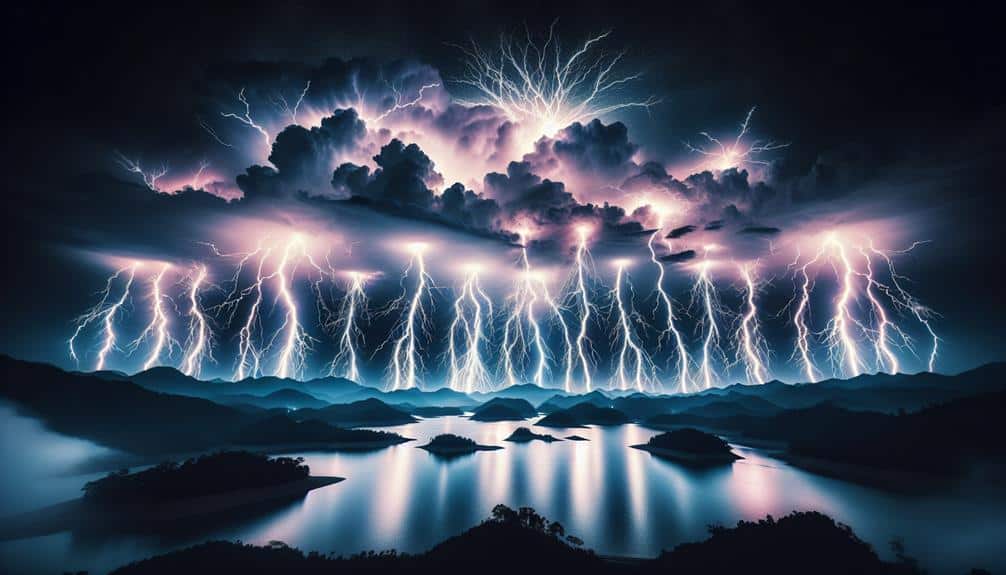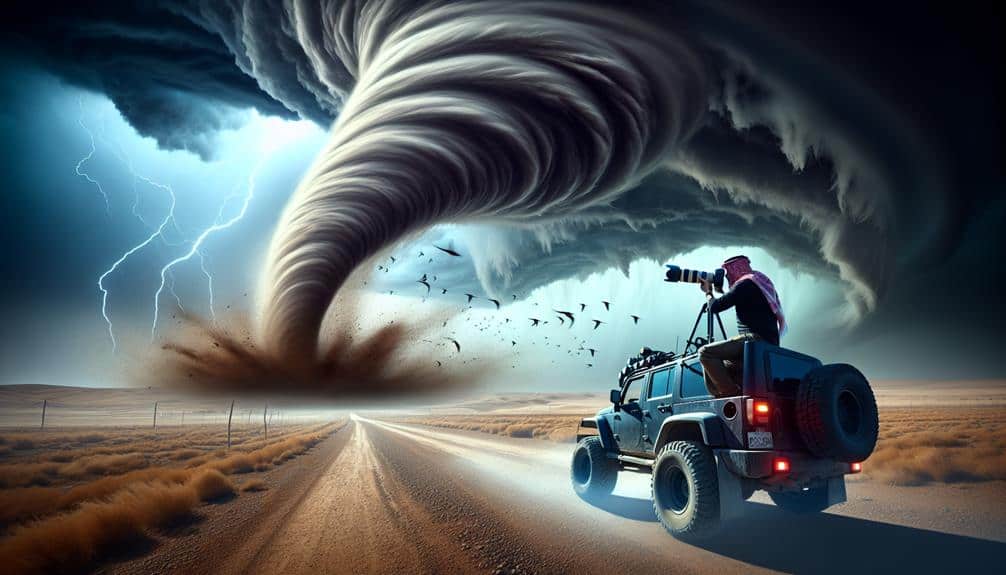Mastering hurricane photography from a helicopter demands meticulous preparation and skilled execution. We'll use compact, high-resolution cameras that can withstand extreme conditions and leverage gyro-stabilized mounts for stability. To capture the storm's grandeur, we position creatively and utilize versatile zoom lenses. Real-time GPS and weather updates help us track and anticipate storm behavior for the best shots. Safety is paramount, with rigorous pre-flight checks and emergency drills. In low light, we adjust ISO settings carefully to reduce noise. Post-processing enhances the dramatic visuals and emphasizes light and shadow interplay. Let's explore how to turn chaos into engaging imagery.
Key Points
- Use fast shutter speeds and gyro-stabilized mounts to ensure clear, stable images.
- Equip compact, high-resolution cameras with versatile zoom lenses for flexibility.
- Conduct thorough pre-flight safety briefings and emergency preparedness drills.
- Adjust ISO settings and exposure compensation to handle low-light conditions effectively.
Choosing the Right Equipment
When capturing the intense drama of a hurricane from a helicopter, we need to make sure our equipment is both sturdy and adaptable. Our cameras must endure harsh weather conditions and deliver high-quality images from an aerial perspective. To achieve this, we prioritize equipment maintenance meticulously. Regular checks ensure that each component—lenses, sensors, and stabilization systems—operates flawlessly even amidst turbulent winds and rain.
For storm tracking, real-time GPS devices are indispensable. They help us stay on course, offering precise coordinates, which are vital when maneuvering through rapidly changing weather conditions. The aerial perspective provides stunning visuals but also demands that our gear is lightweight and easily maneuverable. Compact, high-resolution cameras with powerful zoom capabilities allow us to capture detailed images without compromising movability.
We also rely on drones equipped with advanced imaging technology. These drones, paired with our helicopter, offer dual vantage points, enriching our visual storytelling. Waterproof housings and durable mounts protect our equipment, ensuring it performs at its best throughout the mission.
Understanding Helicopter Safety
Before we take off, we need to focus on helicopter safety protocols.
We'll start with a thorough pre-flight safety briefing to understand all the procedures.
It's also important that we're prepared for emergencies, ensuring we're familiar with the steps to take if something goes wrong.
Pre-flight Safety Briefing
Understanding helicopter safety is vital for capturing stunning hurricane photography while ensuring everyone's well-being. Before stepping onto the helicopter, it's important for us to familiarize ourselves with helicopter procedures and safety equipment. This isn't just standard practice—it's our lifeline.
First, we gather as a team for a comprehensive pre-flight safety briefing. Our pilot and flight crew outline emergency exits, the use of seatbelts, and the location of flotation devices. They demonstrate how to operate the doors and windows, making sure we're fully aware of what to do in case we need to exit swiftly.
Next, we inspect our safety equipment. We check that helmets, harnesses, and life vests are in proper working order. Each piece of gear is essential, providing us with the freedom to concentrate on capturing the perfect shot without any safety concerns.
As photographers, we also need to grasp the weight distribution inside the helicopter. Ensuring our camera gear is securely stowed and evenly distributed helps maintain balance during flight.
Emergency Preparedness Steps
We must be ready for any emergency scenarios that could arise during our helicopter missions to capture hurricane photography. Preparing for these situations guarantees our safety and allows us to focus on getting those perfect shots. Here's what we need to keep in mind:
- Evacuation routes, shelter locations: Knowing our evacuation routes and shelter locations is crucial. We must familiarize ourselves with the area we're flying over and have a clear plan for where to land in case of an emergency. This includes identifying safe landing zones and backup locations.
- Emergency supplies, communication plans: We should always carry essential emergency supplies such as first aid kits, water, and food rations. Additionally, having a robust communication plan in place is essential. This means ensuring all radios, satellite phones, and GPS devices are fully functional and that everyone on board knows how to use them.
Optimal Camera Settings

Selecting the best camera settings is pivotal for capturing the powerful and dynamic scenes of a hurricane from a helicopter. First, let's talk about exposure adjustments and shutter speed techniques.
We need a fast shutter speed, typically around 1/1000th of a second, to freeze the motion of the turbulent clouds and churning ocean below. This guarantees our images are sharp and detailed, even from a moving helicopter. Adjusting the exposure is equally vital; we should aim for a balanced exposure to capture the storm's dramatic contrasts without losing detail in the highlights or shadows.
Next, we focus on white balance settings and focal length considerations. Setting the white balance to 'Cloudy' or manually adjusting it helps maintain the natural colors of the stormy environment, avoiding any unnatural color casts.
As for focal length, a versatile zoom lens, such as a 24-70mm or a 70-200mm, allows us to switch between wide-angle views and close-up shots of specific storm elements without changing lenses mid-flight, which can be challenging and risky.
Capturing the Eye of the Storm
Piloting the helicopter towards the eye of the storm presents a unique opportunity to capture the surreal calm within the surrounding chaos. As we navigate through extreme weather, the aerial perspectives we achieve offer an unparalleled view of the storm's structure. The eye, a tranquil center surrounded by towering walls of clouds, is a visual masterpiece, and it's our job to document this rare phenomenon.
From our vantage point, storm chasing becomes not just an adrenaline-fueled pursuit but a mission to immortalize nature's raw power and beauty through aerial photography. The key is to maintain stability in the helicopter while the storm rages around us, allowing for sharp, clear images.
- Stabilization Techniques: Utilizing gyro-stabilized camera mounts to counteract the helicopter's movements.
- Lens Choices: Opting for wide-angle lenses to capture the vastness of the eye and telephoto lenses for detailed shots of the surrounding eyewall.
Composing Dramatic Shots

Mastering the art of framing the storm's intensity, we focus on balancing elements like cloud formations, light contrasts, and the dynamic landscape below to create compelling visual narratives. Our first priority is to leverage the aerial perspective to capture the grandeur of the hurricane. By positioning ourselves at creative angles, we can highlight the swirling weather patterns and the intricate details of the storm's structure.
Achieving dramatic lighting is crucial. We aim to shoot during times when the sun's rays pierce through the cloud cover, casting sharp contrasts and illuminating the tempestuous scene. This interplay of light and shadow amplifies the storm's ferocity and adds depth to our images.
Understanding weather patterns is vital. We track changes in the storm's behavior and adjust our composition accordingly to feature the most intense and visually striking elements. Moving the helicopter smoothly and steadily, we guarantee each shot captures the raw power and chaos below.
Managing Lighting Challenges
Adapting to the ever-changing light conditions during a hurricane shoot demands precision and adaptability. As we circle the storm, we face a dynamic interplay of shadows, diffused light, and sudden brightness, making our job both challenging and exhilarating. To get those perfect shots, we've got to be constantly aware of the storm tracking and weather conditions.
Using real-time storm tracking apps: These keep us updated on the storm's movements, helping us anticipate changes in lighting.
Leveraging aerial perspectives: By adjusting our altitude and angle, we can capture the interplay of light and shadow across the landscape.
Adjusting camera settings on-the-fly: Quick changes to ISO, aperture, and shutter speed can make all the difference in capturing a well-lit shot.
We often encounter low-light conditions, which can be mitigated with higher ISO settings, but we must be cautious of noise. The dramatic contrasts created by storm clouds and sunlight require us to be adept at using exposure compensation. The right balance can turn a challenging scenario into a visually stunning composition.
Our goal is to master these techniques, ensuring that our editing techniques later on have a solid foundation to work with.
Post-Processing Hurricane Photos

After capturing the raw power of a hurricane, we explore post-processing to enhance the visual impact and bring out the hidden details of our photos. We start with color correction to balance the hues, ensuring the storm's intensity is accurately represented.
Adjusting the contrast helps us highlight the dramatic interplay between light and shadow, which adds depth to the swirling clouds and turbulent seas.
Next, we employ cropping techniques to compose our shots effectively. By removing distractions and focusing on the storm's core, we create a more compelling narrative.
Sharpening details is essential here; it accentuates the swirling motion and intricate patterns within the hurricane, making our images pop.
We also fine-tune exposure to bring out the subtleties in the storm's structure. This step allows us to reveal textures and layers that might be lost in the original shot.
Frequently Asked Questions
How Do You Handle Motion Sickness While Shooting From a Helicopter?
When it comes to preventing nausea and managing dizziness while shooting from a helicopter, we pop a Dramamine, stay hydrated, and focus on the horizon. It's all about keeping our cool and the shots steady.
What Permits Are Required for Aerial Photography During a Hurricane?
For aerial photography during a hurricane, we need permit requirements from the FAA and local authorities. We prioritize safety measures, ensuring our team complies with all regulations while capturing compelling visual storytelling of nature's power.
How Do You Communicate Effectively With the Helicopter Pilot?
We guarantee smooth sailing by providing our pilot with clear instructions and safety precautions. Effective communication and navigation tips are essential for capturing breathtaking visuals while maintaining our freedom to explore the skies with confidence and expertise.
What Are the Best Practices for Weather Forecasting Before a Hurricane Shoot?
For weather forecasting before a hurricane shoot, we should prioritize equipment preparation and safety precautions. We use advanced models and real-time data to guarantee we're ready, guaranteeing our gear and ourselves are safe amidst unpredictable conditions.
How Can You Ensure the Longevity of Your Photography Gear Post-Hurricane Shoot?
After weathering the storm, our gear needs TLC to shine again. We prioritize equipment maintenance and storage, ensuring gear protection through meticulous cleaning. By treating our tools like treasure, we guarantee their longevity and top performance.


